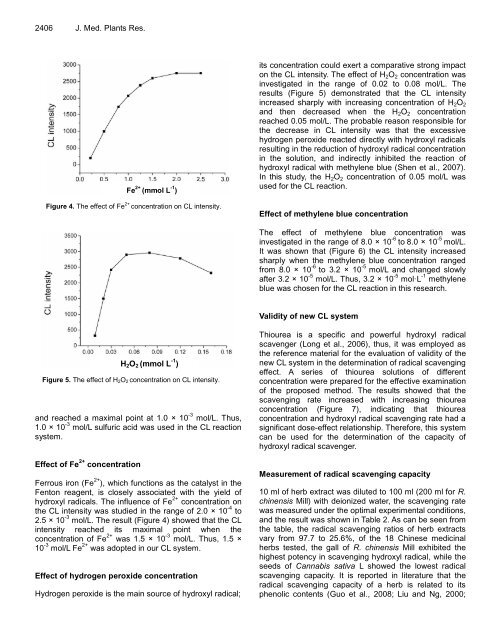Download Complete Issue - Academic Journals
Download Complete Issue - Academic Journals
Download Complete Issue - Academic Journals
You also want an ePaper? Increase the reach of your titles
YUMPU automatically turns print PDFs into web optimized ePapers that Google loves.
2406 J. Med. Plants Res.<br />
Fe 2+ (mmol L -1 )<br />
Figure 4. The effect of Fe 2+ concentration on CL intensity.<br />
H2O2 (mmol L -1 )<br />
Figure 5. The effect of H2O2 concentration on CL intensity.<br />
and reached a maximal point at 1.0 × 10 -3 mol/L. Thus,<br />
1.0 × 10 -3 mol/L sulfuric acid was used in the CL reaction<br />
system.<br />
Effect of Fe 2+ concentration<br />
Ferrous iron (Fe 2+ ), which functions as the catalyst in the<br />
Fenton reagent, is closely associated with the yield of<br />
hydroxyl radicals. The influence of Fe 2+ concentration on<br />
the CL intensity was studied in the range of 2.0 × 10 -4 to<br />
2.5 × 10 -3 mol/L. The result (Figure 4) showed that the CL<br />
intensity reached its maximal point when the<br />
concentration of Fe 2+ was 1.5 × 10 -3 mol/L. Thus, 1.5 ×<br />
10 -3 mol/L Fe 2+ was adopted in our CL system.<br />
Effect of hydrogen peroxide concentration<br />
Hydrogen peroxide is the main source of hydroxyl radical;<br />
its concentration could exert a comparative strong impact<br />
on the CL intensity. The effect of H2O2 concentration was<br />
investigated in the range of 0.02 to 0.08 mol/L. The<br />
results (Figure 5) demonstrated that the CL intensity<br />
increased sharply with increasing concentration of H2O2<br />
and then decreased when the H2O2 concentration<br />
reached 0.05 mol/L. The probable reason responsible for<br />
the decrease in CL intensity was that the excessive<br />
hydrogen peroxide reacted directly with hydroxyl radicals<br />
resulting in the reduction of hydroxyl radical concentration<br />
in the solution, and indirectly inhibited the reaction of<br />
hydroxyl radical with methylene blue (Shen et al., 2007).<br />
In this study, the H2O2 concentration of 0.05 mol/L was<br />
used for the CL reaction.<br />
Effect of methylene blue concentration<br />
The effect of methylene blue concentration was<br />
investigated in the range of 8.0 × 10 -6 to 8.0 × 10 -5 mol/L.<br />
It was shown that (Figure 6) the CL intensity increased<br />
sharply when the methylene blue concentration ranged<br />
from 8.0 × 10 -6 to 3.2 × 10 -5 mol/L and changed slowly<br />
after 3.2 × 10 -5 mol/L. Thus, 3.2 × 10 -5 mol·L -1 methylene<br />
blue was chosen for the CL reaction in this research.<br />
Validity of new CL system<br />
Thiourea is a specific and powerful hydroxyl radical<br />
scavenger (Long et al., 2006), thus, it was employed as<br />
the reference material for the evaluation of validity of the<br />
new CL system in the determination of radical scavenging<br />
effect. A series of thiourea solutions of different<br />
concentration were prepared for the effective examination<br />
of the proposed method. The results showed that the<br />
scavenging rate increased with increasing thiourea<br />
concentration (Figure 7), indicating that thiourea<br />
concentration and hydroxyl radical scavenging rate had a<br />
significant dose-effect relationship. Therefore, this system<br />
can be used for the determination of the capacity of<br />
hydroxyl radical scavenger.<br />
Measurement of radical scavenging capacity<br />
10 ml of herb extract was diluted to 100 ml (200 ml for R.<br />
chinensis Mill) with deionized water, the scavenging rate<br />
was measured under the optimal experimental conditions,<br />
and the result was shown in Table 2. As can be seen from<br />
the table, the radical scavenging ratios of herb extracts<br />
vary from 97.7 to 25.6%, of the 18 Chinese medicinal<br />
herbs tested, the gall of R. chinensis Mill exhibited the<br />
highest potency in scavenging hydroxyl radical, while the<br />
seeds of Cannabis sativa L showed the lowest radical<br />
scavenging capacity. It is reported in literature that the<br />
radical scavenging capacity of a herb is related to its<br />
phenolic contents (Guo et al., 2008; Liu and Ng, 2000;

















